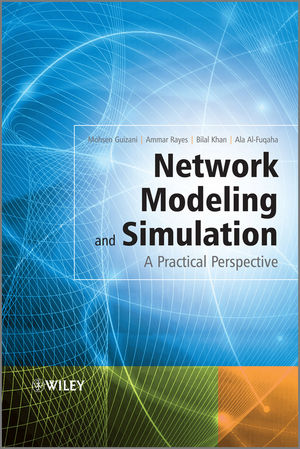|
Textbook
Network Modeling and Simulation: A Practical PerspectiveISBN: 978-0-470-03587-0
Hardcover
304 pages
March 2010, ©2010
 |
||||||
Acknowledgements.
1 Basic Concepts and Techniques.
1.1 Why Is Simulation Important?
1.2 What Is a Model?
1.3 Performance Evaluation Techniques.
1.4 Development of Systems Simulation.
1.5 Summary.
Recommended Reading.
2 Designing and Implementing a Discrete-Event Simulation Framework.
2.1 The Scheduler.
2.2 The Simulation Entities.
2.3 The Events.
2.4 Tutorial 1: Hello World.
2.5 Tutorial 2: Two-Node Hello Protocol.
2.6 Tutorial 3: Two-Node Hello through a Link.
2.7 Tutorial 4: Two-Node Hello through a Lossy Link.
2.8 Summary.
Recommended Reading.
3 Honeypot Communities: A Case Study with the Discrete-Event Simulation Framework.
3.1 Background.
3.2 System Architecture.
3.3 Simulation Modeling.
3.4 Simulation Execution.
3.5 Output Analysis.
3.6 Summary.
Recommended Reading.
4 Monte Carlo Simulation.
4.1 Characteristics of Monte Carlo Simulations.
4.2 The Monte Carlo Algorithm.
4.3 Merits and Drawbacks.
4.4 Monte Carlo Simulation for the Electric Car Charging Station.
4.5 Summary.
Recommended Reading.
5 Network Modeling.
5.1 Simulation of Networks.
5.2 The Network Modeling and Simulation Process.
5.3 Developing Models.
5.4 Network Simulation Packages.
5.5 OPNET: A Network Simulation Package.
5.6 Summary.
Recommended Reading.
6 Designing and Implementing CASiNO: A Network Simulation Framework.
6.1 Overview.
6.2 Conduits.
6.3 Visitors.
6.4 The Conduit Repository.
6.5 Behaviors and Actors.
6.6 Tutorial 1: Terminals.
6.7 Tutorial 2: States.
6.8 Tutorial 3: Making Visitors.
6.9 Tutorial 4: Muxes.
6.10 Tutorial 5: Factories.
6.11 Summary.
Recommended Reading.
7 Statistical Distributions and Random Number Generation.
7.1 Introduction to Statistical Distributions.
7.2 Discrete Distributions.
7.3 Continuous Distributions.
7.4 Augmenting CASiNO with Random Variate Generators.
7.5 Random Number Generation.
7.6 Frequency and Correlation Tests.
7.7 Random Variate Generation.
7.8 Summary.
Recommended Reading.
8 Network Simulation Elements: A Case Study Using CASiNO.
8.1 Making a Poisson Source of Packets.
8.2 Making a Protocol for Packet Processing.
8.3 Bounding Protocol Resources.
8.4 Making a Round-Robin (De)multiplexer.
8.5 Dynamically Instantiating Protocols.
8.6 Putting It All Together.
8.7 Summary.
9 Queuing Theory.
9.1 Introduction to Stochastic Processes.
9.2 Discrete-Time Markov Chains.
9.3 Continuous-Time Markov Chains.
9.4 Basic Properties of Markov Chains.
9.5 Chapman–Kolmogorov Equation.
9.6 Birth–Death Process.
9.7 Little’s Theorem.
9.8 Delay on a Link.
9.9 Standard Queuing Notation.
9.10 The M/M/1 Queue.
9.11 The M/M/m Queue.
9.12 The M/M/1/b Queue.
9.13 The M/M/m/m Queue.
9.14 Summary.
Recommended Reading.
10 Input Modeling and Output Analysis.
10.1 Data Collection.
10.2 Identifying the Distribution.
10.3 Estimation of Parameters for Univariate Distributions.
10.4 Goodness-of-Fit Tests.
10.5 Multivariate Distributions.
10.6 Selecting Distributions without Data.
10.7 Output Analysis.
10.8 Summary.
Recommended Reading.
11 Modeling Network Traffic.
11.1 Introduction.
11.2 Network Traffic Models.
11.3 Traffic Models for Mobile Networks.
11.4 Global Optimization Techniques.
11.5 Particle Swarm Optimization.
11.6 Optimization in Mathematics.
11.7 Summary.
Recommended Reading.
Index.



